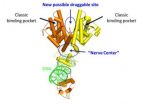(Press-News.org) ORLANDO, Fla., March 13, 2013 – Researchers at Sanford-Burnham Medical Research Institute (Sanford-Burnham) have determined the complete three-dimensional structure of a protein called HNF-4α. HNF-4α controls gene expression in the liver and pancreas, switching genes on or off as needed. People with mature onset diabetes of the young (MODY1), a rare form of the disease, have inherited mutations in the HNF-4α protein. This first-ever look at HNF-4α's full structure, published March 13 in Nature, uncovers new information about how it functions. The study also reveals new pockets in the protein that could be targeted with therapeutic drugs aimed at alleviating MODY1.
"Previous structural studies of HNF-4α and related nuclear receptors only revealed smaller, isolated fragments of these proteins," said Fraydoon Rastinejad, Ph.D., professor in Sanford-Burnham's Diabetes and Obesity Research Center, located at the Institute's Lake Nona campus in Orlando, Fla., and senior author of the study. "Because those studies looked only at separate pieces of HNF-4α, many people suspected there was no coordination between different regions of the protein. But we showed those assumptions are incorrect. HNF-4α's domains are highly organized in a way that has implications for our understanding of MODY1 and the development of treatments for the disease."
Implications for MODY1
Rastinejad's study helps explain why inherited genetic mutations that alter HNF-4α protein structure can be so damaging. The mutations that lead to MODY1 usually occur within a very small, specific region of the HNF-4α protein that's separate from the DNA-binding region. Rastinejad and his team found that, despite their distant location, the mutations telegraph a signal to the DNA-binding region, causing HNF-4α to malfunction and thus MODY1 to develop.
The team also discovered new pockets in the HNF-4α protein that could be targeted with therapeutic drugs. Like other nuclear receptors, HNF-4α has a pocket that binds natural signaling molecules or could be targeted with synthetic drugs. But this new study revealed several other pockets in other regions of the protein. And because they also found cross-communication among different regions on the protein, the team believes that a drug binding a distant pocket could still influence DNA binding.
"We're now working with our colleagues in Sanford-Burnham's Conrad Prebys Center for Chemical Genomics to screen a large chemical library—a collection of around 300,000 compounds—to find molecules that bind to these newly discovered HNF-4α sites," Rastinejad said. "We're looking for molecules that restore DNA binding in MODY1 patients. This way, even if we can't fix the mutation, we can still send a molecule to rescue the receptor's ability to tightly bind DNA."
More about HNF-4α
HNF-4α is a special type of protein called a nuclear receptor. It sits on the DNA in a cell, controlling thousands of genes by switching them on or off in response to outside signals. Nuclear receptors make good drug targets because one region is bound to DNA, while a pocket sits open on another part of the protein, just waiting to hold a signaling molecule. Therapeutic drugs can also be made to fit these pockets, switching the nuclear receptor on or off to alter gene expression.
Until this latest study, many researchers believed that most nuclear receptors are organized like beads on a string. Each bead (protein domain) has a function, but the string itself is just loose. Rastinejad and his team showed that the opposite is true. HNF-4α's domains are organized and coordinated—a domain that receives a signal can actually transmit it to a distant site on the protein. According to Rastinejad, the domains are interconnected, talking to one another.
HNF-4α is found mostly in liver and pancreatic cells, where it turns on genes needed by those organs and keeps other, unnecessary genes off. HNF-4α helps control carbohydrate metabolism, glucose regulation, insulin production, and many other important processes. In other words, HNF-4α is what makes a liver a liver and a pancreas a pancreas.
INFORMATION:
This research was funded by National Institutes of Health—National Institute of Diabetes and Digestive and Kidney Diseases grants R01DK094147and R01DK097475. The study was co-authored by Vikas Chandra, Pengxiang Huang, Nalini Potluri, Dalei Wu, Youngchang Kim, and Fraydoon Rastinejad. Kim is from Argonne National Laboratory; all other authors are from Sanford-Burnham.
About Sanford-Burnham Medical Research Institute
Sanford-Burnham Medical Research Institute is dedicated to discovering the fundamental molecular causes of disease and devising the innovative therapies of tomorrow. Sanford-Burnham takes a collaborative approach to medical research with major programs in cancer, neurodegeneration, diabetes, and infectious, inflammatory, and childhood diseases. The Institute is recognized for its National Cancer Institute-designated Cancer Center and expertise in drug discovery technologies. Sanford-Burnham is a nonprofit, independent institute that employs 1,200 scientists and staff in San Diego (La Jolla), California and Orlando (Lake Nona), Florida. For more information, visit us at sanfordburnham.org.
Molecule's structure reveals new therapeutic opportunities for rare diabetes
3-D structure of HNF-4alpha, a protein mutated in a rare, inherited form of diabetes, reveals new pockets that could be targeted with therapeutic drugs
2013-03-14
ELSE PRESS RELEASES FROM THIS DATE:
New monoclonal antibody developed that can target proteins inside cancer cells
2013-03-14
NEW YORK, MARCH 13, 2013 – Researchers have discovered a unique monoclonal antibody that can effectively reach inside a cancer cell, a key goal for these important anticancer agents, since most proteins that cause cancer or are associated with cancer are buried inside cancer cells. Scientists from Memorial Sloan-Kettering Cancer Center and Eureka Therapeutics have collaborated to create the new human monoclonal antibody, which targets a protein associated with many types of cancer and is of great interest to cancer researchers.
Unlike other human therapeutic monoclonal ...
'Nuisance' data lead to surprising star-birth discovery
2013-03-14
When a batch of bright cosmic objects first appeared in maps in 2008 made with data from the South Pole Telescope, astronomers at the University of Chicago's Kavli Institute for Cosmological Physics regarded it only as an unavoidable nuisance.
The light sources interfered with efforts to measure more precisely the cosmic microwave background—the afterglow of the big bang. But the astronomers soon realized that they had made a rare find in South Pole Telescope's large survey of the sky. The spectra of some of the bright objects, which is the rainbow of light they emit, ...
Carnivores, livestock and people manage to share same space study finds
2013-03-14
In the southern Rift Valley of Kenya, the Maasai people, their livestock and a range of carnivores, including striped hyenas, spotted hyenas, lions and bat-eared foxes, are coexisting fairly happily according to a team of coupled human and natural systems researchers.
"I wouldn't call the results surprising," said Meredith Evans Wagner, a visiting scholar from the University of Florida in the Center for Systems Integration and Sustainability (CSIS) at Michigan State University and part of the research team. "Other research has shown that people and carnivores can coexist, ...
Bursts of star formation in the early universe
2013-03-14
PASADENA, Calif.—Galaxies have been experiencing vigorous bursts of star formation from much earlier in cosmic history than previously thought, according to new observations by a Caltech-led team.
These so-called starburst galaxies produce stars at a prodigious rate—creating the equivalent of a thousand new suns per year. Now the astronomers have found starbursts that were churning out stars when the universe was just a billion years old. Previously, astronomers didn't know whether galaxies could form stars at such high rates so early in time.
The discovery enables ...
1 in 4 colonoscopies in Medicare patients found to be potentially inappropriate
2013-03-14
Colonoscopy is one of the most effective cancer screening procedures available. Colon cancer grows very slowly and can be treated if caught early through screening. But, perhaps because of this success, older Americans are undergoing screening colonoscopies despite recommendations against screening in adults aged 76 and older.
A new study by researchers at the University of Texas Medical Branch at Galveston published online today in JAMA Internal Medicine shows that one out of four colonoscopies paid for by Medicare is potentially inappropriate under current screening ...
More accurate, sensitive DNA test allows early identification of fungus causing WNS
2013-03-14
MADISON, Wis., March 13, 2013 – Even after researchers studying White Nose Syndrome (WNS) established that a fungus called Geomyces destructans is at the heart of the devastating disease, detecting it depended largely on finding dead or dying bats.
This month, the journal Mycologia will publish research by a team of U.S. Forest Service scientists and partners identifying additional species of Geomyces and describing development of a highly sensitive DNA-based technique for early identification of Geomyces destructans on bats as well as in soils and on cave walls.
"The ...
Symbols, such as traffic lights, on menus effective in educating diners
2013-03-14
CHAMPAIGN, Ill. — A little-noticed provision of the Affordable Care Act requires all chain restaurants and retail food establishments with 20 or more locations to list calorie counts on their menus. But according to research co-written by a University of Illinois agricultural economist, numeric calorie labels might not be the most effective way to influence patrons to select "healthier" (often interpreted as lower-calorie) items.
Brenna Ellison, a professor of agricultural and consumer economics, says placing a symbolic label in addition to the numeric calorie information ...
NASA sees large decrease in Cyclone Sandra's rainfall intensity
2013-03-14
NASA's Tropical Rainfall Measuring Mission satellite, also known as TRMM, flew over Cyclone Sandra twice in one day and noticed a large decrease in rainfall intensity over a nine hour period.
On March 11, 2013, NASA's TRMM satellite twice flew above weakening tropical cyclone Sandra as it was passing to the west of New Caledonia in the southern Pacific Ocean. TRMM's Precipitation Radar (PR) had a very good view of Sandra as it passed directly above the tropical cyclone on March 11 at 1312 UTC (9:12 a.m. EST). TRMM PR measured rainfall at the extreme rate of over 206 mm ...
Dwelling on stressful events can increase inflammation in the body, study finds
2013-03-14
ATHENS, Ohio (March 13, 2013)—Dwelling on negative events can increase levels of inflammation in the body, a new Ohio University study finds.
Researchers discovered that when study participants were asked to ruminate on a stressful incident, their levels of C-reactive protein, a marker of tissue inflammation, rose. The study is the first time to directly measure this effect in the body.
"Much of the past work has looked at this in non-experimental designs. Researchers have asked people to report their tendency to ruminate, and then looked to see if it connected to physiological ...
Scientists discover novel chemical that controls cell behavior
2013-03-14
March 12, 2013 — Albuquerque, NM (UNM Cancer Center) — It's the spread of the original cancer tumor that kills most people. That's why cancer researchers vigorously search for drugs that can prevent metastases, the spread of cancer. The research team co-led by Angela Wandinger-Ness, PhD, and Larry Sklar, PhD, at the University of New Mexico Cancer Center has found a chemical compound that appears to control cell migration and adhesion, two important characteristics of metastatic cancer cells. The team recently published a paper describing how the first-in-class compound ...
LAST 30 PRESS RELEASES:
This new understanding of T cell receptors may improve cancer immunotherapies
A new fossil face sheds light on early migrations of ancient human ancestor
A new immunotherapy approach could work for many types of cancer
A new way to diagnose deadly lung infections and save lives
40 percent of MRI signals do not correspond to actual brain activity
How brain-inspired algorithms could drive down AI energy costs
Gum disease may be linked to plaque buildup in arteries, higher risk of major CVD events
Contrails are a major driver of aviation’s climate impact
Structure of dopamine-releasing neurons relates to the type of circuits they form for smell-processing
Reducing social isolation protects the brain in later life
Keeping the heart healthy increases longevity even after cancer
Young adults commonly mix cannabis with nicotine and tobacco
Comprehensive review illuminates tau protein's dual nature in brain health, disease, and emerging psychiatric connections
Book prepares K-12 leaders for the next public health crisis
Storms in the Southern Ocean mitigates global warming
Seals on the move: Research reveals key data for offshore development and international ecology
Sports injuries sustained during your period might be more severe
World's first successful 2 Tbit/s free-space optical communication using small optical terminals mountable on satellites and HAPS
Can intimate relationships affect your heart? New study says ‘yes’
Scalable and healable gradient textiles for multi‑scenario radiative cooling via bicomponent blow spinning
Research shows informed traders never let a good climate crisis go to waste
Intelligent XGBoost framework enhances asphalt pavement skid resistance assessment
Dual-function biomaterials for postoperative osteosarcoma: Tumor suppression and bone regeneration
New framework reveals where transport emissions concentrate in Singapore
NTP-enhanced lattice oxygen activation in Ce-Co catalysts for low-temperature soot combustion
Synergistic interface engineering in Cu-Zn-Ce catalysts for efficient CO2 hydrogenation to methanol
COVID-19 leaves a lasting mark on the human brain
Scientists use ultrasound to soften and treat cancer tumors without damaging healthy tissue
Community swimming program for Black youth boosts skills, sense of belonging, study finds
Specific depressive symptoms in midlife linked to increased dementia risk
[Press-News.org] Molecule's structure reveals new therapeutic opportunities for rare diabetes3-D structure of HNF-4alpha, a protein mutated in a rare, inherited form of diabetes, reveals new pockets that could be targeted with therapeutic drugs





